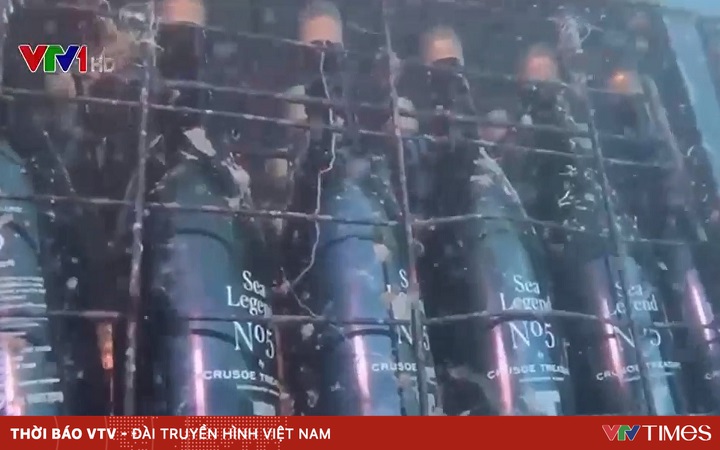The Sarmat super rocket project was started by Russia in 2011 to replace the outdated R-36M series, the first complete launch was carried out more than 10 years later.
President Vladimir Putin announced on April 20 that Russia had successfully tested an RS-28 Sarmat intercontinental ballistic missile (ICBM), one of six “super weapons” he introduced in early 2018. This is the first time. Russia first test-fired a complete Sarmat missile with a maximum range, while previous tests only tested a part of the missile.
The Russian military did not disclose when the Sarmat project was born, but the Russian media said that the development program of this new generation of ICBMs placed in the launch well was started in the 2000s, to replace the R-36M2 model. Voyevoda has been in service since 1988 and has become obsolete.
The Russian ballistic missile model has a global range. Video: Russian Defense Forces.
The project was awarded to the Makeyev Design Institute, which develops a series of Russian long-range ballistic missile models, in early 2011. Many of the country’s defense enterprises also participate in the Sarmat program.
After the research and development process ended in mid-2011, the Makeyev Design Institute shipped the first Sarmat prototype at the end of 2015. But it was not until December 2017 that Russia tested the first booster stage to help the name. the fire left the launch well.
Although this test showed that the projectile system still had some problems, Sarmat was announced by President Putin in his State of the Union address on March 1, 2018, introducing it as one of the “super rockets” capable of could help Russia maintain its military superiority over the West.
The next two tests of the accelerator stage took place in March and May 2018 were successful. After preliminary tests, the commander of the Russian Strategic Missile Forces Sergei Karakayev said that the weapon will be equipped with the 13th Red Flag Missile Division in Orenburg province and the 62nd Red Flag Missile Division in the Oblast region. Krasnoyarsk.

Features of Russia’s Sarmat super missile. Click on the photo to see details.
In June 2019, the Russian Ministry of Defense announced for the first time the tactical specifications of the Sarmat ballistic missile at the Army-2019 military exhibition. Accordingly, the missile has a range of 18,000 km and a total mass of 208 tons, of which the warhead accounts for nearly 10 tons.
Half a year later, Russian Foreign Minister Sergei Lavrov said that the country was ready for US inspectors to visit the Sarmat system to extend the New Strategic Offensive Arms Reduction Treaty (New START).
The RS-28 Sarmat is expected to be fully tested and put into service with the Russian Strategic Missile Forces from 2020, but many technical and financial problems delay the program. On April 20, the first complete Sarmat rocket left the launch pad.
The Russian Defense Ministry on April 21 said that a regiment of advanced missiles in the Krasnoyarsk region is preparing infrastructure to receive the Sarmat line. “The new missile is capable of hitting targets at long distances, using a variety of flight paths. The Sarmat has unique features that allow it to penetrate all current and future missile shields.” , the Russian military emphasized.

The R-36M2 Voevoda missile is expected to be replaced by the RS-28 Sarmat. Image: Russian Defense Forces.
Each Sarmat shell is 35.5 m long, 3 m in diameter, carrying 10-15 independently revolving nuclear warheads (MIRV) with a total power equivalent to 50 million tons of TNT explosives, accompanied by various types of decoys. traps to deceive enemy defenses. The Sarmat can also mount the Avangard hypersonic warhead or various types of hypersonic gliders in the future.
The rocket’s propulsion stage operates in a relatively short time, significantly limiting the ability to be detected by satellites equipped with infrared sensors, making it difficult for the enemy to track and intercept.
With a range of up to 18,000 km, the projectile can be launched around the South Pole, evading the US Arctic-oriented surveillance network. Some experts believe that Sarmat possesses similar features to the Low Orbital Strike Weapon System (FOBS) developed by the Soviet Union during the Cold War, in which the warhead flies many times around the Earth in low orbit. then re-enters the atmosphere and plummets to the target at great speed.
Unnamed sources say that the RS-28 Sarmat battlefield is equipped with the Mozyr active defense system, which is designed to neutralize an enemy’s pre-emptive attack by firing a cloud of arrows. and metal balls, capable of destroying bombs, cruise missiles and nuclear warheads at an altitude of up to 6 km.
“This truly unique weapon will increase the combat capabilities of the armed forces, ensure Russia’s security from external threats, and make those who threaten us think twice. “, President Putin said on Russian television on April 20.
Vu Anh (According to TASS, CSIS)
at Blogtuan.info – Source: vnexpress.net – Read the original article here




